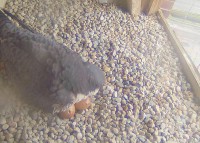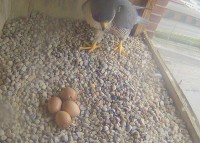Lawrence Peregrines: pip holes!!!
May 13, 2018 in In the Nest Box, lawrence peregrines, Peregrine Falcons Eastern Massachusetts, Peregrine Falcons Massachusetts
Just after 8 AM this morning, overcast skies, light winds and temp 49F. Forecast for day ahead calls for patchy fog before 10am. Otherwise, mostly cloudy, with a high near 65. Calm wind becoming southeast around 5 mph in the afternoon.
 Had a chance to watch for a bit this morning and noticed a pip hole in one of the eggs. The photo at left shows a pip hole in left egg. This means the awaited hatching process in now underway! The male has been very fidgety this morning, moving around and shifting positions constantly. He has been nibbling at gravel pieces and turning the eggs. Around 9:40 AM, the male departed and the female came into the nest box and settled right in on the eggs. The second photo provides a nice look at all four eggs, and again, a pip hole in the egg at top of egg group. Perhaps a chick will pop out later today….stay tuned!
Had a chance to watch for a bit this morning and noticed a pip hole in one of the eggs. The photo at left shows a pip hole in left egg. This means the awaited hatching process in now underway! The male has been very fidgety this morning, moving around and shifting positions constantly. He has been nibbling at gravel pieces and turning the eggs. Around 9:40 AM, the male departed and the female came into the nest box and settled right in on the eggs. The second photo provides a nice look at all four eggs, and again, a pip hole in the egg at top of egg group. Perhaps a chick will pop out later today….stay tuned!
 So what is going on as we await hatching of the eggs? Inside each egg, the peregrine chick has its head tucked under its wing. A large muscle called the hatching muscle runs from the middle of the neck to the top of the head. Typically around 30 days after incubation has started, this muscle contracts. The chick’s head snaps up and the egg tooth, a hard pointed knob on top of the beak, cracks the inside of the eggshell. This creates a “pip” – a small hole with tiny cracks spreading out across the shell. One to two days after pipping, the chick begins moving around in the shell. The egg tooth scrapes against the eggshell, cutting a ring through it. Just over 30 days after the egg is laid, the chick breaks out!
So what is going on as we await hatching of the eggs? Inside each egg, the peregrine chick has its head tucked under its wing. A large muscle called the hatching muscle runs from the middle of the neck to the top of the head. Typically around 30 days after incubation has started, this muscle contracts. The chick’s head snaps up and the egg tooth, a hard pointed knob on top of the beak, cracks the inside of the eggshell. This creates a “pip” – a small hole with tiny cracks spreading out across the shell. One to two days after pipping, the chick begins moving around in the shell. The egg tooth scrapes against the eggshell, cutting a ring through it. Just over 30 days after the egg is laid, the chick breaks out!
Literature cited:
The Raptor Resource Project, Deborah, Iowa
